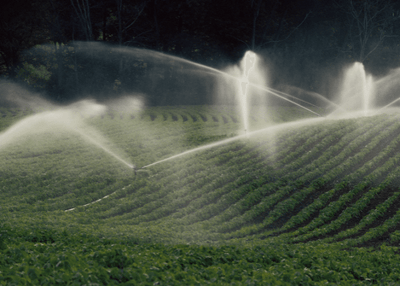While useful, lead is highly toxic...roughly 25% of households in the United States with children under the age of six contain significant amounts of lead-contaminated paint, dust, water, or soil. The American Academy of Pediatrics states that there is no safe level of lead exposure in children. Adults exposed to lead may experience gastrointestinal diseases and/or damage to the cardiovascular system, reproductive system, brain, kidneys, and liver.
Water Quality InformationWritten By Actual Experts
RSSLead Contamination in Drinking Water: What You Need To Know
Nitrates in Drinking Water

Analies Dyjak | Policy Nerd
Fertilizers, pesticides, and other types of stormwater runoff are common sources of drinking water contamination in the United States. Nitrogen is a major ingredient in agricultural and household fertilizers that are used to promote growth. Algal blooms occur when photosynthesis production spikes due to an influx of nutrients, which is frequently associated with nitrogen-based fertilizers. If you have ever seen a bright green body of water, it may have been because of nitrogen overloading. Municipal water systems typically have the proper technology to filter out nitrates, but the higher the concentration, the harder they are to filter. Groundwater wells are by far the most at risk for nitrate contamination. Private wells are not regulated and detection of nitrates or other contaminants is impossible without expensive testing.
Health Effects of Nitrates in Drinking Water
Nitrate contamination can result in methemoglobinemia or "baby blue" disease. This occurs when nitrate-contaminated tap water is used to prepare infant formula. This life-threatening disease reduces the blood’s ability to carry oxygen throughout the body. Nitrates are colorless and odorless, and thus difficult to detect. Nitrates in the environment do not pose a considerable health risk unless they’re ingested, in which case they are reduced to nitrites within the body. Nitrites are then further reduced to N-nitroso compounds which are known carcinogens and are also linked to other health problems. You may be familiar with this compound because it can be found in processed meats and vegetables that are high in vitamin E. Bladder and thyroid cancer, as well as birth defects are the primary health risks associated with nitrate contamination.
Non-Point Source Pollution
Nitrate contamination in water is associated with non-point source pollution from agriculture, residential lawn maintenance, and recreational field maintenance. Unlike point source pollution which originates from factories and other industrial sites, non-point source pollution is much more difficult to regulate. Point sources are regulated by National Pollution Discharge Elimination System (NPDES) permits which include allowable levels of pollution and best practices for managing contamination. Non-point pollution culminates from various different sources, some of which are unknown. This makes identifying “responsible parties” a very difficult task. Non-point sources are regulated through Water Quality Management Plans under Section 319 of the Clean Water Act. Water Quality Management Plans include Best Management Practices (BMP’s), implementation plans, and deadlines that must all be approved by the Environmental Protection Agency.
How are Nitrates Regulated?
The Environmental Protection Agency set a Maximum Contaminant Level of 10 parts per million, which is an enforceable standard that public water systems must comply with. As previously stated, public water supplies should be equipped to handle nitrate contamination, but this isn’t always the case. For example, a 2015 study completed in various communities in Iowa concluded that 11 public water sources exceeded federal limits. The study also concluded that 880 municipal water systems were considered to be “highly susceptible to becoming contaminated by nitrates and other pollutants.” If you live in an agricultural area, we recommend using a filtration system to reduce the risk of nitrate contamination in your water.
As always, we encourage you to take advantage of Hydroviv's "Help No Matter What" technical support policy, where we answer questions related to nitrates in drinking water and water filtration. Drop us a line at hello@hydroviv.com.
Other Articles We Think You Might Enjoy:Algal Blooms and Cyanotoxins
Raw Water is Bad!
Agricultural Runoff and Water Contamination
Problems We Found In San José , California Drinking Water

Problems We Found In Norman, Oklahoma's Drinking Water

Analies Dyjak | Policy Nerd
**Updated September 30, 2020 to include current data
For Hydroviv’s assessment of Norman, Oklahoma drinking water, we aggregated water quality test data provided by the city's Consumer Confidence Report, the U.S. Environmental Protection Agency and supplemental health information. We cross referenced the city’s water quality test data with toxicity studies in scientific and medical literature. The water filters that we sell at Hydroviv are optimized to filter out contaminants that are found in Norman's drinking water.
Chromium 6 In Norman's Drinking Water
Chromium 6 is a highly toxic metal that is currently unregulated by the EPA. Chromium 6 pollution is associated with metal processing, tannery facilities, chromate production, stainless steel welding, and pigment production. Norman, Oklahoma has some of the highest levels of Chromium 6 in the country. In the 2020 Consumer Confidence Report, the city of Norman tested for Total Chromium, instead of Chromium 6 - which is a far more toxic type of chromium. According to test data completed by the Environmental Working Group, the average concentration of Chromium 6 detected in Norman's drinking water was 39,300 parts per trillion. For a bit of perspective, these levels are as high as 1,965 times higher than the concentration determined to have negligible impact on cancer risk. EPA has acknowledged that Chromium 6 is a known human carcinogen through inhalation, but is still determining its cancer potential through ingestion of drinking water. Lung, nasal and sinus cancers are associated with Chromium 6 exposure. Acute respiratory disease, cardiovascular, gastrointestinal, hematological, hepatic, renal, and neurological distress are health effects associated with high levels of chromium 6 exposure.
Arsenic in Norman's Drinking Water
Norman, Oklahoma has a big problem with Arsenic in drinking water. The current levels of Arsenic in Norman drinking water are 14.4 parts per billion. The allowable level (also known as the Maximum Contaminant Level) for Arsenic in municipal tap water is 10 parts per billion. This is the first time in recent years that Norman has had high levels of Arsenic in drinking water. In previous years, Arsenic levels have been 2 parts per billion, which is well below the federal standard.
Chloramine In Norman’s Drinking Water
While most municipalities use chlorine as the primary drinking water disinfectant, Norman’s drinking water is disinfected with chloramine. Chloramine is primarily responsible for what many customers report as the “bad taste” or “pool smell” of tap water. Concentrations were detected as high as 3.9 parts per million in treated water, which is just under the EPA Maximum Contaminant Level of 4 parts per million. Unlike chlorine, chloramine does not dissipate if a container of water is left in the refrigerator overnight. Most one-size-fits-all water filters use filtration media that doesn’t do a great job removing chloramine, but the filters that we design and build at Hydroviv for Norman use a special filtration media that is purposefully designed to remove chloramine.
Strontium In Norman’s Drinking Water
Strontium is an unregulated contaminant that was also detected in this years water quality report. Strontium naturally occurs in certain vegetables, grain, and livestock but is also a byproduct of coal and oil combustion. Concentrations of Strontium in Norman's drinking water were detected as high as 442 parts per billion. For a bit of perspective, this is twice as high as concentrations found in Oklahoma City. According to the Agency for Toxic Substances and Disease Registry, children are the most susceptible age group to the negative health effects associated with Strontium exposure. Bone growth can be effected if children ingest high enough concentrations through drinking water.
It’s important to note that only a handful of contaminants are required to be included in annual Consumer Confidence Reports, and that there are hundreds of potentially harmful unregulated contaminants that aren’t accounted for. If you’re interested in learning more about water filters that have been optimized for Norman's tap water quality, feel free to visit www.hydroviv.com to talk to a Water Nerd on our live chat feature or send us an email at hello@hydroviv.com.
Other Articles We Think You Might Enjoy:5 Things To Know About Chromium 6 In Drinking Water
Chlorine vs. Chloramine: What You Need To Know
2018 Oklahoma City Water Quality Report
Hartford, Connecticut Drinking Water
Analies Dyjak | Policy Nerd
For Hydroviv’s city of Hartford, Connecticut's drinking water quality report, we collected water quality test data from Hartford's annual Consumer Confidence Report and the U.S. Environmental Protection Agency. We cross referenced water quality data with toxicity studies in scientific and medical literature. The water filters that we sell at Hydroviv are optimized to filter out contaminants that are found in Hartford's drinking water.
Where Does Hartford Source Its Drinking Water?
Hartford sources its drinking water from surface water reservoirs throughout the massive Farmington River Watershed. Because Hartford’s source water is entirely surface, pollution that’s discharged into the river or its tributaries has the potential to enter drinking water. Hartford, as well as the rest of the state of Connecticut, has a long industrial history. Hartford drinking water has contaminants associated with industrial activities such as Strontium, Barium, Vanadium and Chromium 6. Additionally, hormones caused by household waste were detected in the city of Hartford's most recent drinking water quality report.
Lead In Hartford Drinking Water
Hartford is an older city, so it’s no surprise that lead contamination is a big problem. Lead enters tap water through old lead service pipes and lead-containing plumbing. 10% of sites tested for lead had concentrations over 4 parts per billion. But the highest level detected in Hartford drinking water was 148 parts per billion. Environmental Protection Agency, Center for Disease Control, and American Academy of Pediatrics all recognize that there is no safe level of lead for children. Additionally, municipalities are only required to test a handful of homes every few years, so the levels reported in Hartford’s annual water quality report might not reflect the lead levels in your tap water. Lead exposure can cause developmental issues, lowered IQ, and damages to the kidneys and brain.
Disinfection Byproducts In Hartford Drinking Water
Hartford also has a serious problem with disinfection byproducts or DBPs. DBPs are formed when chlorine-based disinfectants that are routinely added to the water supply to kill bacteria, react with organic matter. In this years report, concentrations of haloacetic acids ranged from 7.7 to 38.2 parts per billion and 15.3 to 72.8 parts per billion for trihalomethanes. For a bit of perspective, EPA’s maximum contaminant level for haloacetic acids is 60 parts per billion and 80 parts per billion for trihalomethanes. While Hartford's water quality is technically in compliance with EPA’s threshold, regulatory agencies have very little knowledge about the adverse health effects of DBPs, and their toxicity. EPA has stated that they have been linked to an increased risk of bladder cancer, as well as kidney, liver, and central nervous system problems.
Other Articles We Think You Might EnjoyLead In Drinking Water: What You Need To Know
What Are Disinfection Byproducts?
Breakdown of The Lead and Copper Rule




